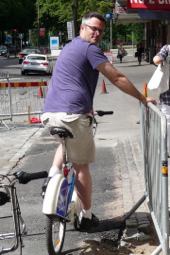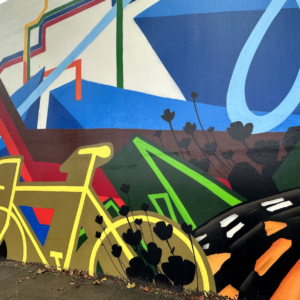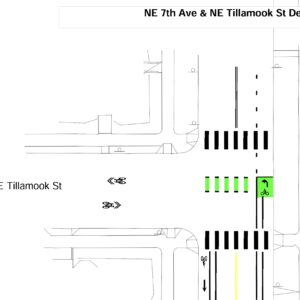
track in Stockholm, wants Portland to
compare itself to Europe’s best
biking cities.
(Photo: Tom Miller)
At a press conference today, Mayor-Elect Sam Adams announced major changes to how Portland will do business under his administration.
Along with new budget guidelines and new bureau assignments for City Commissioners, he also unveiled structural reforms — like a consolidation of the Bureau of Planning and the Office of Sustainable Development into the Bureau of Sustainable Planning & Development.
The plan was detailed in an eight-page memo to “All Portlanders” that was titled, “Improving ‘The City that Works'”. (You can read the full text here.)
Amid the changes listed in the document are a few lines that indicate Adams’ ongoing desire to set Portland’s sights on Europe when it comes to bike-friendliness.
Under the heading, “Service Efforts and Accomplishments Reports”, are the words (emphasis mine):
We have asked the auditor to augment the current list of comparator cities in the SEA Report to include “best in class” cities from around the globe. This will ensure we know how well Portland performs against not only similarly-situated cities but also cities with inspiring characteristics, e.g. the share of transportation trips made by bicycle in Copenhagen, Amsterdam, Stockholm, Vancouver, BC, etc.
The SEA is an annual report by the City’s Audit Services Division that has been compiled for nearly 20 years. It rates the City’s performance on a variety of services from fire safety to water quality. (I reported on the transportation-related findings in the most recent SEA report).
What Adams has done here, is to formalize within the City a comparison of Portland to the best bike cities in the world.
The Audit Services Division has long used what they call “comparison cities” to use as benchmarks for Portland. I asked Audit Services Public Information Officer Robert Cowan to give us a bit of context for how they’re used.
“The comparison cities are used in our annual SEA report. They allow us to see how we stack up on very specific measures to other cities,” Cowan said.
Cowan says adding in the new comparison cities as per Adams’ request is still being worked out, but he expects it will happen.
This may seem like a small thing, but being able to compare Portland’s bike mode split to the truly world-class biking cities will be a major eye-opener to residents and policymakers who aren’t as familiar with the comparisons as us bike geeks.
Having the City Auditor present those comparisons in an official report gives them a formality that is much different than rhetoric from politicians or fist-pumping from advocates.
This move is just the latest example of the impact that European cities are having on Portland’s transportation planners. Adams, his staffers, city traffic engineeers, and many local bike planners have recently been to Copenhagen, Amsterdam, etc… and with the title of “Best American Bike City” already wrapped up, their goals are increasingly focused on Europe.






Thanks for reading.
BikePortland has served this community with independent community journalism since 2005. We rely on subscriptions from readers like you to survive. Your financial support is vital in keeping this valuable resource alive and well.
Please subscribe today to strengthen and expand our work.
did I already say, “wow?”
I think it would be great to see, along with comparisons of Portland to European cities like Copenhagen and Amsterdam, some advertising pointed at getting normal people out on bikes – even just show pictures of people from those European cities, who look just like people you run into on the streets here pedaling around with groceries, handbags, even Christmas trees. I think in Portland, the “cycling community” can tend to still be looked at as kind of a special group of people who are either more sporty or willing to brave the elements or are just trying to get into shape – and I think the reason those European countries have such high rates of cycling is that people there just view it as transportation, the way we view cars. When you want to go somewhere, you just hop on your bike.
Of course, infrastructure will make a big difference there as well (57% of Copenhageners said they ride bikes because it’s quick and easy), but I think people just seeing bikes used as transportation for normal everyday types of things will start to get them thinking more and more about even the feasibility of doing so themselves, especially for short trips (a couple miles or less).
Let’s see some media come out that portrays (and I believe truthfully, even without the infrastructure of the Netherlands), that cycling can be a quick, easy, enjoyable mode of transportation for those types of everyday trips, but without any jabs at other modes of transport. Let’s not only compare ourselves with those European cities in terms of numbers, but show people in the city what it can be like there – what it can be like here.
It’s exciting to see changes happening, and hopefully that trend will continue.
I hope to see bike mode share increase dramatically. But Copenhagen? Amsterdam? Not a chance. Why not see realistic and achievable goals, say a 10 percent bike commute mode share?
I think that the latest bike counts were that 8 percent bike commute mode share. We can blow past 10 percent in a year or two! You’re right though, Copenhagen numbers are a bit out of reach.
“Copenhagen numbers are a bit out of reach.”
Citywide, perhaps. But there are several sections of the inner city where we can definitely see 30-40% bike mode split.
We have invested very little in places that now see 13-15% mode split (inner NE and SE). Please try to imagine what an innovative and fully funded bike plan might actually do.
Imagine if we had connected, efficient, comfortable and safe bike routes from the major residential areas in N, NE, SE into downtown. The potential is there… all that’s missing is the political will and a bit more money.
I don’t think the ‘latest bike counts’ are done very well. I don’t know what Portland’s bike mode share is for commute trips, but I know it is not 8 percent. I’d guess it’s probably closer to 5. Which is still extremely good and something we should all be proud of, especially the folks helping to make it happen.
At 10 percent yearly growth (and I’m talking real growth), it would take about 7 years to reach a 10 percent mode share. That’s a realistic, worthwhile and achievable goal. That is what the city should be aiming for.
I can imagine what an innovative and fully funded bike plan can do! But to see definitely see a 30-40 percent mode share? Jonathan, don’t kid yourself.
Mr. or Ms. Don’t Believe The Hype, (above, #6):
Well, just where did those who performed the counts, and those PDOT and other engineers and designers who interpreted ’em screw up to have not done them “very well,” using industry-standard traffic count methods? Is your entire posting based upon your “guess?”
It is well that you are enthusiastic about growing mode share, but do you have some other data set that PDOT missed this year? Yeah, Jonathan shoots for the moon in his 30-40% aspiration. I “guess” that’s cuz he believes…
Why compare with Copenhagen and Amsterdam ? They only have modal shares for bicycles of around 37-40 %. Groningen has 60% of journeys by bike across the city.
There are areas in any city which are higher, of course. That includes Groningen where many of the streets in the centre have no cars at all and no buses. Just bikes.
The infrastructure isn’t optional. To get such high modal share all year around you need to get everyone cycling, not just fit cycling enthusiasts. They also need to do so whatever the weather.
You need to clear snow. You need to keep people feeling safe in fog.
My children cycle to school alone every day even if there is snow or fog.
Alright, let’s get the show on the road. I’m excited to see Sam start to do some crazy things in Portland that are standard in those European cities mentioned above.
Dear doubters:
Do you think Copenhagen started out as a bike utopia? Doubtful. The first rule of accomplishing anything is that you must be able to imagine it first. Good for Sam for dreaming big. If you aim for the moon, you might just hit a star.
(Jonathan, I’m attempting to subscribe to comments again…)
I agree with Don’t Believe the Hype that the count methodology and analysis are significantly flawed. A critical look at the Auditor’s SEA survey results and the count data and comparison with results from Census data shows significant differences. Some of it simply doesn’t add up.
For a start, people don’t seem to recognize that commute work trips are only about 1/5 to 1/4 of total trips and gains in work trip share do not necessarily translate into similar increases bikes for all trips.
Second, the Auditor’s survey asked about primary mode of work trips as well as the secondary mode and the proportion of time the secondary mode was used. It’s clear from the data that the secondary mode is used rather often (probably between 30 and 40 percent of the time). Unfortunately, the data has not been analyzed to determine which modal combinations are most often “paired.”
Third, the vast majority of the counts were conducted for only a two-hour period. There appears to have been no serious work done to determine how that two-hour peak compares with the actual daily volumes.
I’m not saying that we’ve had anything less than great progress in the last few years, but as Mark Twain says “There are lies, damn lies, and statistics.”
Oh, I forgot to mention that I actually lived in Copenhagen for most of a year. And I’ve bicycled in several European countries as an unsupported, independent bicycle tourist.
Right on, Kronda! Back in the early 1990s, when the Bicycle Master Plan was brand new, when the BTA had just been founded, and when Portland’s bike facilities consisted of a few green “bike route” signs that led nowhere, naysayers doubted that bicycling would ever achieve any kind of mode share. Many people shook their heads and said that American adults just don’t want to use bikes for transportation and that building infrastructure for bikes wouldn’t make any difference.
Thankfully, Portland city officials agreed to give bicycle infrastructure a try. Now here we are, getting close to a 10% mode split. It’s proof that American adults (and kids, too) DO want to get there by bike — they just don’t want to get killed in the process, so they won’t get on a bike unless they feel safe.
Plain and simple: if you make bicycling safe and comfortable, people will bicycle. Up to now, bicycle infrastructure has been built with pocket change in our transportation budgets (less than 2% of transportation budgets!! That’s next to nothing!!!). Every single European city that has high rates of bicycling has achieved those rates by having their elected leaders decide that they want a bicycling-friendly city. They set a goal to increase bike usage, they made sure to amply fund bike projects and programs, and their citizens responded by bicycling.
Sam gets it — building for bikes is extremely cost-effective and results in healthier citizens and a cleaner city. With adequate funding and good planning, I have no doubt that we could replicate European success with increasing bike usage. All it takes is political will.
I see he has kept the various emergency management functions fragmented, he better hope we don’t have a subduction earthquake, as his legacy will be very different from what he’s aiming for.
“If you build it, they will come” is a fantasy. If you build it, yes, some will come, but more will come if you whack the reluctant ones in the back of the head with $4/gal fuel tax and $1,000/yr registration fee.
I have read Danish and Dutch governments were pretty clear a generation ago that their intent was to reduce VMT. They were also clear that they were going to making driving both more expensive and more difficult as part of the tool kit to accomplish this goal.
From my long distance observations, it appears that the Danes and the Dutch have a much higher tolerance for taxes and government regulation than the average US voter. That leaves Sam in a tough place. I applaud his efforts, and seeing metrics that compare Portland to other cities will be fun, but aping Europe never works well in the US. We will have to find our own path, and culture and business will play more of a role than they did in Europe.
Sam is looking a bit pudgy..
Coyote: The cost of owning and using a car in the UK is very similar to that of owning and using one in the Netherlands.
However, Britain’s cycling rate remains around 1% of all journeys just like in the US.
The difference between those two countries is in the infrastructure. This is what makes cycling possible for the masses in the Netherlands. It’s not by any means a fantasy – you can visit the country for yourself and see the result of 30 years of progress.
Carrots work better than sticks. Make cycling into a convenient and safe means of getting about and people choose to do it. They choose to tell their loved ones to get on and do it too.
Pricing people out of their cars doesn’t make cycling attractive – it merely makes driving expensive. Unless cycling is attractive people keep driving. That’s the experience of the UK.
I’ve lived in both countries.
How much money has Portland spent on having staff travel to Amsterdam, Copenhagen, etc.? Sounds inappropriste to me.